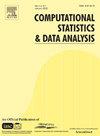Multi-model subset selection
IF 1.5
3区 数学
Q3 COMPUTER SCIENCE, INTERDISCIPLINARY APPLICATIONS
引用次数: 0
Abstract
The two primary approaches for high-dimensional regression problems are sparse methods (e.g., best subset selection, which uses the -norm in the penalty) and ensemble methods (e.g., random forests). Although sparse methods typically yield interpretable models, in terms of prediction accuracy they are often outperformed by “blackbox” multi-model ensemble methods. A regression ensemble is introduced which combines the interpretability of sparse methods with the high prediction accuracy of ensemble methods. An algorithm is proposed to solve the joint optimization of the corresponding -penalized regression models by extending recent developments in -optimization for sparse methods to multi-model regression ensembles. The sparse and diverse models in the ensemble are learned simultaneously from the data. Each of these models provides an explanation for the relationship between a subset of predictors and the response variable. Empirical studies and theoretical knowledge about ensembles are used to gain insight into the ensemble method's performance, focusing on the interplay between bias, variance, covariance, and variable selection. In prediction tasks, the ensembles can outperform state-of-the-art competitors on both simulated and real data. Forward stepwise regression is also generalized to multi-model regression ensembles and used to obtain an initial solution for the algorithm. The optimization algorithms are implemented in publicly available software packages.
多模型子集选择
解决高维回归问题的两种主要方法是稀疏方法(如最佳子集选择,在惩罚中使用 ℓ0 正态)和集合方法(如随机森林)。虽然稀疏方法通常能产生可解释的模型,但就预测准确性而言,它们往往比 "黑箱 "多模型集合方法更胜一筹。本文介绍了一种回归集合方法,它结合了稀疏方法的可解释性和集合方法的高预测准确性。通过将稀疏方法的 ℓ0 优化的最新发展扩展到多模型回归集合,提出了一种算法来解决相应的 ℓ0 惩罚回归模型的联合优化问题。集合中的稀疏和多样化模型是同时从数据中学习的。这些模型中的每一个都能解释预测因子子集与响应变量之间的关系。关于集合的经验研究和理论知识被用来深入了解集合方法的性能,重点是偏差、方差、协方差和变量选择之间的相互作用。在预测任务中,集合方法在模拟数据和真实数据上的表现都优于最先进的竞争对手。前向逐步回归也被推广到多模型回归集合中,并用于获得算法的初始解。这些优化算法是在公开的软件包中实现的。
本文章由计算机程序翻译,如有差异,请以英文原文为准。
求助全文
约1分钟内获得全文
求助全文
来源期刊

Computational Statistics & Data Analysis
数学-计算机:跨学科应用
CiteScore
3.70
自引率
5.60%
发文量
167
审稿时长
60 days
期刊介绍:
Computational Statistics and Data Analysis (CSDA), an Official Publication of the network Computational and Methodological Statistics (CMStatistics) and of the International Association for Statistical Computing (IASC), is an international journal dedicated to the dissemination of methodological research and applications in the areas of computational statistics and data analysis. The journal consists of four refereed sections which are divided into the following subject areas:
I) Computational Statistics - Manuscripts dealing with: 1) the explicit impact of computers on statistical methodology (e.g., Bayesian computing, bioinformatics,computer graphics, computer intensive inferential methods, data exploration, data mining, expert systems, heuristics, knowledge based systems, machine learning, neural networks, numerical and optimization methods, parallel computing, statistical databases, statistical systems), and 2) the development, evaluation and validation of statistical software and algorithms. Software and algorithms can be submitted with manuscripts and will be stored together with the online article.
II) Statistical Methodology for Data Analysis - Manuscripts dealing with novel and original data analytical strategies and methodologies applied in biostatistics (design and analytic methods for clinical trials, epidemiological studies, statistical genetics, or genetic/environmental interactions), chemometrics, classification, data exploration, density estimation, design of experiments, environmetrics, education, image analysis, marketing, model free data exploration, pattern recognition, psychometrics, statistical physics, image processing, robust procedures.
[...]
III) Special Applications - [...]
IV) Annals of Statistical Data Science [...]
 求助内容:
求助内容: 应助结果提醒方式:
应助结果提醒方式:


